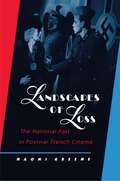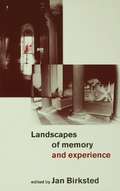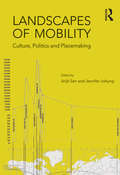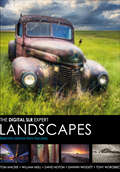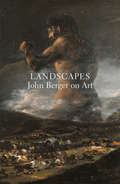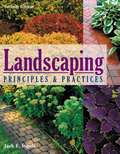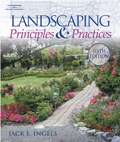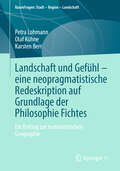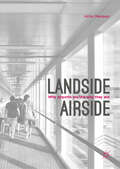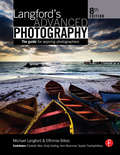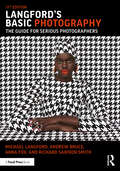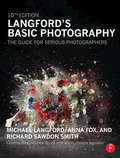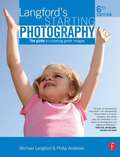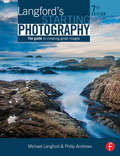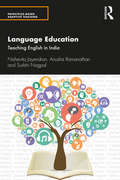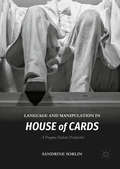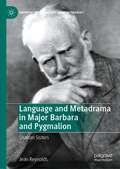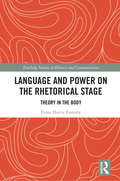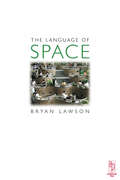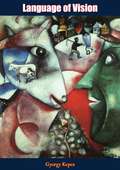- Table View
- List View
Landscapes of Loss: The National Past in Postwar French Cinema
by Naomi GreeneIn Landscapes of Loss, Naomi Greene makes new sense of the rich variety of postwar French films by exploring the obsession with the national past that has characterized French cinema since the late 1960s. Observing that the sense of grandeur and destiny that once shaped French identity has eroded under the weight of recent history, Greene examines the ways in which French cinema has represented traumatic and defining moments of the nation's past: the political battles of the 1930s, the Vichy era, decolonization, the collapse of ideologies. Drawing upon a broad spectrum of films and directors, she shows how postwar films have reflected contemporary concerns even as they have created images and myths that have helped determine the contours of French memory. This study of the intricate links between French history, memory, and cinema begins by examining the long shadow cast by the Vichy past: the repressed memories and smothered unease that characterize the cinema of Alain Resnais are seen as a kind of prelude to a fierce battle for national memory that marked so-called rétro films of the 1970s and 1980s. The shifting political and historical perspectives toward the nation's more distant past, which also emerged in these years, are explored in the light of the films of one of France's leading directors, Bertrand Tavernier. Finally, the mood of nostalgia and melancholy that appears to haunt contemporary France is analyzed in the context of films about the nation's imperial past as well as those that hark back to a "golden age," a remembered paradis perdu, of French cinema itself.
Landscapes of Memory and Experience
by Jan BirkstedIt has been argued that the history of landscape and of gardens has been marginalized from the mainstream of art history and visual studies because of a lack of engagement with the theories, methods and concepts of these disciplines. This book explores possible ways out of this impasse in such a way that landscape studies would become pivotal through its theoretical advances, since landscape studies would challenge the underlying assumptions of traditional phenomenological theory. Thus the history and theory of twentieth-century landscape might not only once again share concepts and methods with contemporary art and design history, but might in turn influence them.A complementary sequel to Relating Architecture to Landscape, this volume of essays explores further areas of interest and discussion in the landscape/architecture debate and offers contributions from a team of well-known researchers, teachers and writers. The choice of topics is wide-ranging and features case studies of modern and contemporary schemes from the USA, Far East and Australasia.
Landscapes of Mobility: Culture, Politics, and Placemaking
by Jennifer JohungOur world is unquestionably one in which ubiquitous movements of people, goods, technologies, media, money, and ideas produce systems of flows. Comparing case studies from across the world, including those from Benin, the United States, India, Mali, Senegal, Japan, Haiti, and Romania, this book focuses on quotidian landscapes of mobility. Despite their seemingly familiar and innocuous appearances, these spaces exert tremendous control over our behavior and activities. By examining and mapping the politics of place and motion, this book analyzes human beings’ embodied engagements with their built world and provides diverse perspectives on the ideological and political underpinnings of landscapes of mobility. In order to describe landscapes of mobility as a historically, socially, and politically constructed condition, the book is divided into three sections-objects, contacts, and flows. The first section looks at elements that constitute such landscapes, including mobile bodies, buildings, and practices across multiple geographical scales. As these variable landscapes are reconstituted under particular social, economic, ecological, and political conditions, the second section turns to the particular practices that catalyze embodied relations within and across such spaces. Finally, the last section explores how the flows of objects, bodies, interactions, and ecologies are represented, presenting a critical comparison of the means by which relations, processes, and exchanges are captured, depicted, reproduced and re-embodied.
Landscapes: Expert advice from top pros (The Digital SLR Expert)
by David Noton Tom Mackie William Neill Darwin Wiggett Tony WorobiecHEADLINE: Build and Refine Your In-Camera and Photoshop Skills with This Authoritative and Visually Stunning Guide to Capturing Incredible Landscape Photographs Practical demonstrations, step-by-step examples and invaluable secrets from five leading professional photographers show you how to use your digital SLR to its full potential Darwin Wiggett, David Noton, William Neill, Tom Mackie and Tony Worobiec tackle subjects key to taking great landscape images: controlling exposure; understanding light; composing shots; choosing the perfect location and working in black and white Breathtaking photography showcases a wide variety of landscape locations from coasts to mountains, cities to countryside and deserts to forests, highlighting the versatility and full potential of digital photography
Landscapes: John Berger on Art
by John BergerA major new work from the world's leading writer on artAs leading radical writer on art John Berger celebrates his ninetieth year, he brings a lifetime's engagement with the ideas, artists, and thinkers that have shaped his thinking: Walter Benjamin, Rosa Luxemburg and Bertolt Brecht among them. In Landscapes Berger allows us to see the evolution of his own way of seeing. He explores the relationship between creativity and politics and the revolutionary potential of art through a series of different forms.As always, in this book, Berger pushes at the limits of art writing, demonstrating beautifully how his painter's eyes lead him to refer to himself only as a storyteller. A landscape is, to John Berger, like a portrait, an animating, liberating metaphor rather than a rigid definition. Landscapes offers a tour of the history of art, but not as you know it.Landscapes brings together Berger's most penetrating insights into how we may engage with both art and the artist in society.From the Hardcover edition.
Landscaping Principles & Practices
by Jack E. IngelsLandscaping: Principles & Pratices, 7th Edition provides the basic knowledge and industry information needed to be successful in the field of landscape design and architecture. Focusing on three areas of professional practice; design, contracting and management, traditional topics such as design, plant installation, and pricing are covered, as well as topics not found in most other books, such as interior landscaping, xeriscaping, water gardens, and safety.
Landscaping Principles And Practices (6th Edition)
by Jack E. IngelsNewly reorganized and updated, the fifth edition of this popular text offers a comprehensive introduction to landscape management. To present a balanced view of the industry as a process, the text is now organized by the industry's three career areas - design, contracting, and maintenance - to illustrate the interdependence of these areas. New material covers such current topics as xeriscaping and landscape calculations, providing students with the latest in landscaping techniques and management. Excellent for launching students into landscaping careers!
Landscaping: Principles and Practices (7th edition)
by Jack IngelsLandscaping: Principles & Practices, 7th Edition provides the basic knowledge and industry information needed to be successful in the field of landscape design and architecture. Focusing on three areas of professional practice; design, contracting and management, traditional topics such as design, plant installation, and pricing are covered, as well as topics not found in most other books, such as interior landscaping, xeriscaping, water gardens, and safety.
Landschaft und Gefühl – eine neopragmatistische Redeskription auf Grundlage der Philosophie Fichtes: Ein Beitrag zur humanistischen Geographie (RaumFragen: Stadt – Region – Landschaft)
by Olaf Kühne Karsten Berr Petra LohmannDie Befassung mit ‚Landschaft‘ hat in den letzten Jahren in der Öffentlichkeit und den Wissenschaften an Bedeutung gewonnen. In Philosophie, Humangeographie und Sozialwissenschaften haben sich unterschiedliche Traditionen im Umgang mit ‚Landschaft‘ entwickelt. Diese werden in dem vorliegenden Buch hinsichtlich ihrer Tauglichkeit für einen Beitrag zur Analyse und Regelung von Landschaftskonflikten und daraufhin untersucht, Antworten auf die landschaftsbezogenen Herausforderungen der Gegenwart sowohl in Bezug auf Wissenschaft als auch Gesellschaft zu leisten. Zentraler Ansatzpunkt ist die Erörterung des Selbstverhältnisses des Individuums im Konflikt, die im Rückgriff auf Fichtes Theorie des Gefühls im Rahmen einer Philosophie des Subjekts erfolgt. Mit dieser Theorie soll insbesondere die Einseitigkeit wissenschaftlicher Zugänge zum Individuum angegangen werden, die einerseits in der überproportionalen Betonung der Ratio und andererseits in der fehlenden Verortung des Gefühls zuallererst im Individuum selbst besteht. Die mangelnde Beachtung der Binnenperspektive des Individuums im Konflikt führt zu einer Bedeutungsferne des Konflikts für das Individuum sowie infolgedessen zur Verunklarung der konfliktären Situation und damit letztlich Unfähigkeit sinnvollen Handelns bezogen auf die Regelung eines solchen Konflikts. Mit diesem Zugang erweitern wir den sich aktuell in Entwicklung befindlichen neopragmatistischen Ansatz der Landschaftsforschung und stellen die Bedeutung eines humanistischen Ansatzes zu Landschaft heraus, der den Menschen als fühlendes und sittliches Wesen in das Zentrum der Überlegungen stellt. Damit leistet das Buch einen Beitrag zur Redeskription der humanistischen Geographie.
Landside | Airside: Why Airports Are the Way They Are
by Victor MarquezWhy do we love and hate airports at the same time? Have you been a victim of tiresome walks, congestion, long lines, invasive pat-downs, eternal delays and so on? Perhaps no other technological system has been challenged by continuously changing paradigms like airports. Think a minute on rail stations; think of how successful are the rail networks of the world in connecting nations, with just minimum security measures. Why aviation and airports are so radically different in this regard?In order to answer those questions the author embarks on a thorough revision of airport history and airport planning that in the end builds up a new theory about how airports are formed from the outset. Within its journey from the early airfield to the newest hubs of today, Dr. Marquez identifies for the first time the Landside–Airside boundary as the single most important feature that shapes an airport. In this sense, his finding challenges the “historical linearity” that, until today, used to explain a century of airports.From both an analytical and theoretical S&TS stance, Dr. Marquez assures that it is only when airports needed to be fully reinvented (LaGuardia, Dulles and Tampa) when they become transparent and we may be able to understand their lack of technological stability.
Langford's Advanced Photography: The Guide For Aspiring Photographers (Advanced Photography Ser.)
by Michael Langford Efthimia BilissiLangford's Advanced Photography is the only advanced photography guide a serious student or aspiring professional will ever need. In this eighth edition, Efthimia Bilissi continues in the footsteps of Michael Langford by combining an unrivalled level of technical detail with a straightforward writing style while simultaneously bringing the text firmly in to the digital era.This book covers the entire photographic process from a technical standpoint - not only detailing the 'how' but also explaining the 'why' that is so often missing from photography texts. From the workings of cameras, lenses, digital imaging sensors and software to new hot topics such as HDR imaging, digital asset management, and even running your own photography business, everything a serious photographer could need to extend their art into professional realms is covered.The book also benefits from a full glossary, charts and inspirational full color images throughout, with summaries and projects at the end of each chapter to reinforce the theory.
Langford's Basic Photography: The Guide for Serious Photographers
by Michael Langford Andrew Bruce Anna Fox Richard Sawdon SmithThis seminal photography text, now in its 11th edition, has been revamped, reorganized, and modernized to include the most up-to-date and need-to-know information for photographers. Introducing all the key concepts and fundamentals of photography, this book is a must-have for any photographer’s bookcase.Providing examples and practical information throughout to allow photographers to apply concepts to their own work, the text explains the fundamentals of photography in an accessible way. Fully updated to reflect the dynamic changes in the industry, this 11th edition includes expanded and updated content focusing on advances in camera technology and digital lighting, connecting with the global photography industry and professional networks through social media, updated images throughout, and a new chapter on new digital outputs.Ideal as a foundational text for students of photography as well as a key reference for professionals.
Langford's Basic Photography: The Guide for Serious Photographers
by Richard Sawdon Smith Anna FoxThis seminal photography text, now in its 10th edition and celebrating its 50th anniversary, has been revamped, reorganized, and modernized to include the most up-to-date, need to know information for photographers. Ideal for students, beginners, and advanced users wanting to brush up on the fundamentals of photography, this book is a must have for any photographer’s bookcase. The heart of this text, however, retains the same comprehensive mix of scholarly and practical information. The new edition has been fully updated to reflect dynamic changes in the industry. These changes include: an expansion and overhaul of the information on digital cameras and digital printing; an emphasis on updating photographs to include a wider range of international work; replacement of many diagrams with photos; overhaul of the analogue sections to give a more modern tone (ie exposure measurement and film and filters with some more dynamic photo illustrations).
Langford's Starting Photography: The Guide to Creating Great Images
by Philip Andrews Michael Langford'The' Focal Press introductory photography book, this authoritative classic by leading photography writer and lecturer Michael Langford has been refreshed and revised by best-selling photography author Philip Andrews for today's photographers. Strongly focused on digital, but with key references to traditional photography where relevant, to offer a full grounding in the topic, Langford's Starting Photography is an ideal technical introduction. All the core basics are included, from how to select and compose a good picture to how different cameras operate and how to decipher their controls. Different subjects are explored, with advice on how to tackle people, places, animals, landscapes and close-ups, and valuable guidance on presenting and assessing finished work. This established, detailed beginner's guide is the perfect choice if you're looking to develop your knowledge and skills, and take your photography to the next level.
Langford's Starting Photography: The Guide to Creating Great Images
by Philip AndrewsStarting with the basics of camera control and moving on to shutter speeds, aperture, zoom and flash, Langford’s Starting Photography gives you the only introduction to digital photography you’ll ever need. Once you’ve mastered the basics, examples and projects allow you to explore the key methods for capturing a variety of subjects from portraits and pets to landscapes and sports photography, alongside straightforward advice on using editing software to get the best out of your digital shots, will have you producing unforgettable images in moments. More inspiring than a textbook, more interesting than a reference, and more in-depth than a photography class, Langford’s Starting Photography is the only guide you need to start taking great images.
Language & Peace (War And Peace Ser. #Vol. 6)
by Christina Schäffne Anita L. WendenFirst published in 1999. Routledge is an imprint of Taylor & Francis, an informa company.
Language Education: Teaching English in India (Principles-based Adaptive Teaching)
by Nishevita Jayendran Anusha Ramanathan Surbhi NagpalThis book situates the teaching and learning of language in general, and English in particular, within the sociocultural context of India. It engages with current scholarship in literacy studies and the pedagogies of language acquisition and learning. The volume discusses the cultural, discursive and sociopolitical functions of language education and the teaching of English in Indian schools. It examines the importance of adopting flexible pedagogical and multimodal strategies in teaching vocabulary; grammar; literary genres like fiction, poetry and drama; rhetorical discourses; and communicative English to learners for whom English is not one of their home language(s). It also discusses pragmatic approaches to curriculum design for communicative competence and critical literacy rooted in theoretical principles of language education. The authors analyse issues relevant to secondlanguage acquisition; English language teaching (ELT); emergent, adult and critical literacies; and critical pedagogies in language and literature. Written in an accessible style, the book comes with case studies, exercises and additional references to support an independent exploration of the fields. This book will be of interest to students and teachers of language, literature and education, as well as teachers and educators in schools and universities. It is also of relevance to policymakers, non-governmental organisations and public and private sector bodies that work in the fields of language and literacy.
Language and Manipulation in House of Cards
by Sandrine SorlinThis book is to date the first monograph-length study of the popular American political TV series House of Cards. It proposes an encompassing analysis of the first three seasons from the unusual angles of discourse and dialogue. The study of the stylistic idiosyncrasies of the ruthless main protagonist, Frank Underwood, is completed by a pragmatic and cognitive approach exposing the main characters' manipulative strategies to win over the other. Taking into account the socio-cultural context and the specificities of the TV medium, the volume focuses on the workings of interaction as well as the impact of the direct address to the viewer. The book critically uses the latest theories in pragmatics and stylistics in its attempt at providing a pragma-rhetorical theory of manipulation.
Language and Media: A Resource Book for Students (Routledge English Language Introductions)
by Rodney H. Jones Sylvia Jaworska Erhan AslanRoutledge English Language Introductions cover core areas of language study and are one-stop resources for students. Assuming no prior knowledge, books in the series offer an accessible overview of the subject, with activities, study questions, sample analyses, commentaries, and key readings—all in the same volume. The innovative and flexible 'two-dimensional' structure is built around four sections—introduction, development, exploration, and extension— which offer self-contained stages for study. Each topic can also be read across these sections, enabling the reader to build gradually on the knowledge gained. This revised second edition of Language and Media: Provides an accessible introduction and comprehensive overview of the major approaches and methodological tools used in the study of language and media. Focuses on a broad range of media and media content from more traditional print and broadcast media formats to more recent digital media formats. Incorporates practical examples using real data, including newspaper articles, press releases, television shows, advertisements (print, broadcast, and digital), blogs, social media content, internet memes, culture jamming, and protest signs. Includes key readings from leading scholars in the field, such as Jan Blommaert, Sonia Livingstone, David Machin, Martin Montgomery, Ruth Page, Ron Scollon, and Theo van Leeuwen. Offers a wide range of activities, questions, and points for further discussion. The book emphasises the increasingly creative ways ordinary people are engaging in media production. It also addresses a number of urgent current concerns around media and media production/reception, including fake news, clickbait, virality, and surveillance. Written by three experienced teachers and authors, this accessible textbook is an essential resource for all students of English language and linguistics.
Language and Metadrama in Major Barbara and Pygmalion: Shavian Sisters (Bernard Shaw and His Contemporaries)
by Jean ReynoldsThis book focuses on two important topics in Shaw’s Major Barbara and Pygmalion that have received little attention from critics: language and metadrama. If we look beyond the social, political, and economic issues that Shaw explored in these two plays, we discover that the stories of the two “Shavian sisters”— Barbara Undershaft and Eliza Doolittle—are deeply concerned with performance and what Jacques Derrida calls “the problem of language.” Nearly every character in Major Barbara produces, directs, or acts in at least one miniature play. In Pygmalion, Henry Higgins is Eliza’s acting coach and phonetics teacher, as well as the star of an impromptu, open-air phonetics show. The language content in these two plays is just as intriguing. Did Eliza Doolittle have to learn Standard English to become a complete human being? Should we worry about the bad grammar we hear at Barbara Undershaft’s Salvation Army shelter? Is English losing its precision and purity? Meanwhile, in the background, Shaw keeps reminding us that language and theatre are always present in our everyday lives—sometimes serving as stabilizing forces, and sometimes working to undo them.
Language and Power on the Rhetorical Stage: Theory in the Body (Routledge Studies in Rhetoric and Communication)
by Fiona Harris RamsbyThrough a fusion of narrative and analysis, Language and Power on the Rhetorical Stage examines how theater can enact critical discourse analysis and how micro-instances of iniquitous language use have been politically and historically reiterated to oppress and deny equal rights to marginalized groups of people. Drawing from Aristophanes’ rhetorical plays as a template for rhetoric in action, the author poses the stage as a rhetorical site whereby we can observe, see, and feel 20th-century rhetorical theories of the body. Using critical discourse analysis and Judith Butler’s theories of the performative body as a methodological and analytical lens, the book explores how a handful of American plays in the latter part of the 20th century—the works of Tony Kushner, Suzan Lori-Parks, and John Cameron Mitchell, among others— use rhetoric in order to perform and challenge marginalizing language about groups that are not offered center stage in public and political spheres. This innovative study initiates a conversation long overdue between scholars in rhetorical and performance studies; as such, it will be essential reading for academic researchers and graduate students in the areas of rhetorical studies, performance studies, theater studies, and critical discourse analysis.
Language of Space
by Bryan LawsonThis unique guide provides a systematic overview of the idea of architectural space. Bryan Lawson provides an ideal introduction to the topic, breaking down the complex and abstract terms used by many design theoreticians when writing about architectural space. Instead, our everyday knowledge is reintroduced to the language of design. Design values of 'space' are challenged and informed to stimulate a new theoretical and practical approach to design.This book views architectural and urban spaces as psychological, social and partly cultural phenomena. They accommodate, separate, structure, facilitate, heighten and even celebrate human spatial behaviour.
Language of Space and Form
by James EcklerA unique graphical guide for using architectural terminology to jump-start the design process This design studio companion presents architectural terms with special emphasis on using these terms to generate design ideas. It highlights the architectural thinking behind the terminology and helps readers gain a thorough understanding of space and form. Featuring double-page spreads with over 190 illustrated entries, the book fully explores, analyzes, and cross-references key elements and techniques used in architecture and interior design. Each entry first defines the common meaning of the term, then goes on to discuss in detail its generative possibilities. Scenarios involving the use of a design principle, or the way it might be experienced, further aid students in developing strategies for their own design. In addition, Language of Space and Form: Divides entries into five categories for quick access to concepts, including process and generation, organization and ordering, operation and experience, objects and assemblies, and representation and communication Addresses studio practice from the ground up, encouraging readers to develop creativity and critical thinking as they develop a design process Offers supplemental online learning resources, including exercises that correspond to the book A must-have reference for professionals and students in architecture and interior design, Language of Space and Form is destined to become a classic introduction to design thinking.
Language of Vision
by Gyorgy KepesLANGUAGE OF VISION is a timely, courageous book without parallel in its field. It deals with present-day problems of visual expression from a realistic and human point of view, and endeavors to escape from the narrow confines of the laboratory, preserving the closest possible contact with our experiences of every day life. It makes an extensive analysis of the structure and function of the graphic image in painting, photography and advertising design. It inquires deeply into the laws of visual organization and evaluates in contemporary terms the various representation devices conceived by artists of all ages such as—size, vertical location, overlapping, transparency, perspective, interpenetration, light and color, movement, etc., etc.318 illustrations supplement the text. There is a great variety of subject matter, techniques and media. They include photograms, photomontages and collages; analytical diagrams, typography, calligraphy and lettering; pre-historic art, paintings and drawings by children; significant work of the old masters and contemporary artists including Arp, Braque, Duchamp, Degas, Juan Gris, Helion, Klee, Kandinsky, Leger, Malevich, Matisse, Moholy-Nagy, Miro, Mondrian, Picasso, Seurat and many others. Advertising design by Bayer, Binder, Beall, Burtin, Cassandre, Carlu, Doesburg, Lissitzky, Man Ray, McKnight Kauffer, Sutnar, Tschichold, etc., etc.LANGUAGE OF VISION with its completely new concept of appraisal and revaluation is a book of vital importance to every one who feels the urgent need for a clearer understanding of the structure and function of art in our society.
Language, Youth and Identity in the 21st Century
by Jacomine Nortier Bente A. SvendsenThe language of young people is central in sociolinguistic research, as it is seen to be innovative and a primary source of knowledge about linguistic change and the role of language. This volume brings together a team of leading scholars to explore and compare linguistic practices of young people in multilingual urban spaces, with analyses ranging from grammar to ideology. It includes fascinating examples from cities in Europe, Africa, Canada and the US to demonstrate how young people express their identities through language, for example in hip-hop lyrics and new social media. This is the first book to cover the topic from a globally diverse perspective, and it investigates how linguistic practices across different communities intersect with age, ethnicity, gender and class. In doing so it shows commonalities and differences in how young people experience, act and relate to the contemporary social, cultural and linguistic complexity of the twenty-first century.
